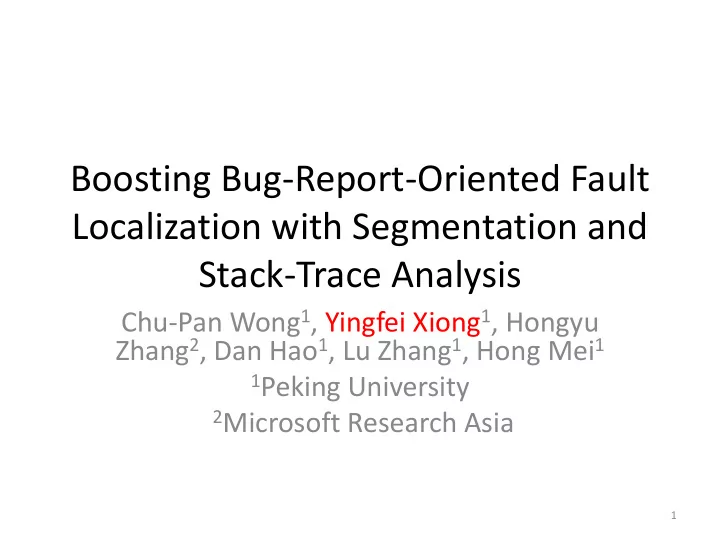

Boosting Bug-Report-Oriented Fault Localization with Segmentation and Stack-Trace Analysis Chu-Pan Wong 1 , Yingfei Xiong 1 , Hongyu Zhang 2 , Dan Hao 1 , Lu Zhang 1 , Hong Mei 1 1 Peking University 2 Microsoft Research Asia 1
INTRODUCTION 2
Background Large amount Painstaking • Eclipse got 4414 bug • 11892 source code reports in 2009 files in Eclipse 3.1 • No prior knowledge for new developers Software Project Team 3
Bug-Report-Oriented Fault Localization Bug reports as queries Rate source files by heuristics Ranked list of source code files Developers 4
This Talk Two new heuristics 5
A Typical Approach -- BugLocator • Combining three heuristics • First heuristic: VSM (vector space model) similarity between the bug report and files – Each document represented as a vector of token weights – Token weight = token frequency × inverse document frequency 6
An Example for VSM 7
A Typical Approach -- BugLocator • Second heuristic: large files – Existing studies show that large files has higher fault density • Third heuristic: similar bug reports – The files modified in the fix of a previously similar bug report are more likely to contain faults • Final score = VSM score × large file score + similar bug report score 8
Existing Problem 1 • Noise in large source code files – When file size changes, fault density may change more than an order of magnitude – BugLocator: large file score range from 0.5~0.73 – Large files may have much noise 9
Motivation Example - Noise • If BugLocator is used • Problems • Accessible.java is – Noisy words ranked 1 st • “access” • TextConsoleViewer.java • “invalid” • “call” (real fix) is ranked 26 th 10
Our solution - Segmentation Using segmentation technique, TextConsoleVie wer.java is ranked to 1 st Accessible.java TextConsoleViewer.java 11
Existing Problem 2 • Stack Traces Information – Direct clues for bugs – Often treated as plain text 12
Motivation Example – Stack Traces Table.java is suspicious Table.java is ranked to 252 nd in BugLocator. 13
APPROACH 14
Segmentation • Extract a corpus – Lexical tokens – Keywords removal (e.g. float, double) – Separation of concatenated word (e.g. isCommitable) – Stop words removal (e.g. a, the) • Evenly divide corpus into segments – Each segment contains n words • VSM score = the highest score of all segments 15
Fixing Large File Scores 1 • 𝑀𝑏𝑠𝑓𝐺𝑗𝑚𝑓𝑇𝑑𝑝𝑠𝑓 #terms = 1+𝑓 −𝛾×𝑂𝑝𝑠(#𝑢𝑓𝑠𝑛𝑡) • Function 𝑂𝑝𝑠 normalize values to [0, 1] based on even distribution • Parameter 𝛾 in BugLocator is always 1 • Can be a larger number in our approach 16
Stack-Trace Analysis • Extract file names from stack traces ( D ) • Identify closely related files by imports ( C ) • A defect is typically located in one of the top-10 stack frames 17
Calculating Final Scores for Source Code Files Modified BugLocator Score Final Score BoostScore 18
EVALUATION 19
Subjects and Parameters • Parameters • Segmentation Size n = 800 • Large File Factor 𝛾 =50 • No universally best values 20
Metrics • Standard ones also used in BugLocator • Top N Rank of Files (TNRF) – The percentage of bugs whose any related files are listed in top N of returned files • Mean Reciprocal Rank (MRR) – How high the first related files are ranked 𝐶𝑆 1/𝑠𝑏𝑜𝑙(𝑗) Σ 𝑗=1 𝑁𝑆𝑆 = – |𝐶𝑆| • Mean Average Precision (MAP) – How high all related files are ranked 𝑛 𝑗/𝑄𝑝𝑡(𝑗) Σ 𝑗=1 𝐵𝑤𝑄 = – 𝑛 – 𝑁𝐵𝑄 = the mean value of 𝐵𝑤𝑄 for all bug reports 21
Overall Effectiveness 22
Effectiveness of Segmentation 23
Effectiveness of Stack-Trace Analysis 24
Summary of Main Findings Our approach is able to significantly outperform BugLocator Either segmentation or stack-trace analysis is an effective technique Segmentation and stack-trace analysis complement each other 25
RELATED WORK 26
Parallel Work • [L2R] X. Ye, R. Bunescu , and C. Liu, “Learning to rank relevant files for bug reports using domain knowledge,” in Proc. FSE , 2014, pp. 66 – 76. • [BLUiR] R. K. Saha, M. Lease, S. Khurshid , and D. E. Perry, “Improving bug localization using structured information retrieval,” in Proc. ASE , 2013, pp. 345 – 355. • B. Sisman and A. C. Kak , “Assisting code search with automatic query reformulation for bug localization,” in Proc. MSR , 2013, pp. 309 – 318. • T.- D. B. Le, S. Wang, and D. Lo, “Multi -abstraction concern localiza- tion ,” in Proc. ICSM , 2013, pp. 364 – 367. • C. Tantithamthavorn, A. Ihara, and K. ichi Matsumoto, “Using co - change histories to improve bug localization performance,” in Proc. SNPD , 2013, pp. 543 – 548. The two heuristics in our approach are different from all parallel work 27
Comparison with L2R and BLUiR • AspectJ – Better than L2R, Better than BLUiR • SWT – Better than L2R, Worse than BLUiR • Eclipse – Worse than L2R, Similar to BLUiR The two heuristics are probably orthogonal to other heuristics, and can be combined 28
More Parallel Work • Laura Moreno, John Joseph Treadway, Andrian Marcus, Wuwei Shen. On the Use of Stack Traces to Improve Text Retrieval-Based Bug Localization. ICSME 2014 • Rongxin Wu, Hongyu Zhang, Shing-Chi Cheung and Sunghun Kim. CrashLocator: Locating Crashing Faults based on Crash Stacks, ISSTA 2014 • Ripon K. Saha, Julia Lawall, Sarfraz Khurshid, Dewayne E. Perry. On the Effectiveness of Information Retrieval Based Bug Localization for C Programs. ICSME 2014 • Shaowei Wang, David Lo, Julia Lawall. Compositional Vector Space Models for Improved Bug Localization. ICSME 2014 29
Thanks for your attention! Code and data available at: http://brtracer.sourceforge.net/ 30
Recommend
More recommend